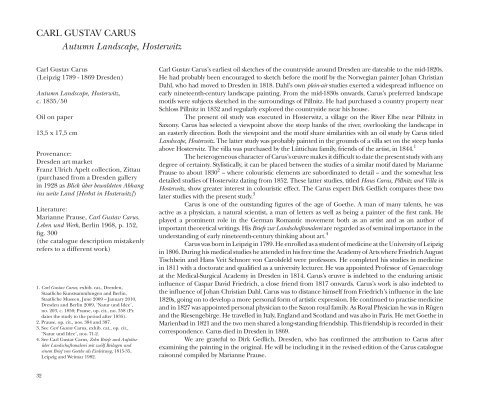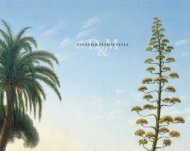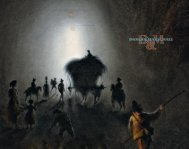Catalogue 2010 - daxer & marschall
Catalogue 2010 - daxer & marschall
Catalogue 2010 - daxer & marschall
Create successful ePaper yourself
Turn your PDF publications into a flip-book with our unique Google optimized e-Paper software.
CARL GuSTAV CARuS<br />
Autumn Landscape, Hosterwitz<br />
Carl Gustav Carus<br />
(Leipzig 1789 - 1869 Dresden)<br />
Autumn Landscape, Hosterwitz,<br />
c. 1835/50<br />
Oil on paper<br />
13,5 x 17,5 cm<br />
Provenance:<br />
Dresden art market<br />
Franz ulrich Apelt collection, Zittau<br />
(purchased from a Dresden gallery<br />
in 1928 as Blick über bewaldeten Abhang<br />
ins weite Land [Herbst in Hosterwitz])<br />
Literature:<br />
Marianne Prause, Carl Gustav Carus.<br />
Leben und Werk, Berlin 1968, p. 152,<br />
fig. 300<br />
(the catalogue description mistakenly<br />
refers to a different work)<br />
1. Carl Gustav Carus, exhib. cat., Dresden,<br />
Staatliche Kunstsammlungen and Berlin,<br />
Staatliche Museen, June 2009 – January <strong>2010</strong>,<br />
Dresden and Berlin 2009, ‘Natur und Idee’,<br />
no. 203, c. 1850; Prause, op. cit., no. 358 (Pr.<br />
dates the study to the period after 1835).<br />
2. Prause, op. cit., nos. 384 and 387.<br />
3. See Carl Gustav Carus, exhib. cat., op. cit.,<br />
‘Natur und Idee’, nos. 71-2.<br />
4. See Carl Gustav Carus, Zehn Briefe und Aufsätze<br />
über Landschaftsmalerei mit zwölf Beilagen und<br />
einem Brief von Goethe als Einleitung, 1815-35,<br />
Leipzig and Weimar 1982.<br />
32<br />
Carl Gustav Carus’s earliest oil sketches of the countryside around Dresden are dateable to the mid-1820s.<br />
He had probably been encouraged to sketch before the motif by the Norwegian painter Johan Christian<br />
Dahl, who had moved to Dresden in 1818. Dahl’s own plein-air studies exerted a widespread influence on<br />
early nineteenth-century landscape painting. From the mid-1830s onwards, Carus’s preferred landscape<br />
motifs were subjects sketched in the surroundings of Pillnitz. He had purchased a country property near<br />
Schloss Pillnitz in 1832 and regularly explored the countryside near his house.<br />
The present oil study was executed in Hosterwitz, a village on the River Elbe near Pillnitz in<br />
Saxony. Carus has selected a viewpoint above the steep banks of the river, overlooking the landscape in<br />
an easterly direction. Both the viewpoint and the motif share similarities with an oil study by Carus titled<br />
Landscape, Hosterwitz. The latter study was probably painted in the grounds of a villa set on the steep banks<br />
above Hosterwitz. The villa was purchased by the Lüttichau family, friends of the artist, in 1844. 1<br />
The heterogeneous character of Carus’s œuvre makes it difficult to date the present study with any<br />
degree of certainty. Stylistically, it can be placed between the studies of a similar motif dated by Marianne<br />
Prause to about 1830 2 – where colouristic elements are subordinated to detail – and the somewhat less<br />
detailed studies of Hosterwitz dating from 1852. These latter studies, titled Haus Carus, Pillnitz and Villa in<br />
Hosterwitz, show greater interest in colouristic effect. The Carus expert Dirk Gedlich compares these two<br />
later studies with the present study. 3<br />
Carus is one of the outstanding figures of the age of Goethe. A man of many talents, he was<br />
active as a physician, a natural scientist, a man of letters as well as being a painter of the first rank. He<br />
played a prominent role in the German Romantic movement both as an artist and as an author of<br />
important theoretical writings. His Briefe zur Landschaftsmalerei are regarded as of seminal importance in the<br />
understanding of early nineteenth-century thinking about art. 4<br />
Carus was born in Leipzig in 1789. He enrolled as a student of medicine at the university of Leipzig<br />
in 1806. During his medical studies he attended in his free time the Academy of Arts where Friedrich August<br />
Tischbein and Hans Veit Schnorr von Carolsfeld were professors. He completed his studies in medicine<br />
in 1811 with a doctorate and qualified as a university lecturer. He was appointed Professor of Gynaecology<br />
at the Medical-Surgical Academy in Dresden in 1814. Carus’s œuvre is indebted to the enduring artistic<br />
influence of Caspar David Friedrich, a close friend from 1817 onwards. Carus’s work is also indebted to<br />
the influence of Johan Christian Dahl. Carus was to distance himself from Friedrich’s influence in the late<br />
1820s, going on to develop a more personal form of artistic expression. He continued to practise medicine<br />
and in 1827 was appointed personal physician to the Saxon royal family. As Royal Physician he was in Rügen<br />
and the Riesengebirge. He travelled in Italy, England and Scotland and was also in Paris. He met Goethe in<br />
Marienbad in 1821 and the two men shared a long-standing friendship. This friendship is recorded in their<br />
correspondence. Carus died in Dresden in 1869.<br />
We are grateful to Dirk Gedlich, Dresden, who has confirmed the attribution to Carus after<br />
examining the painting in the original. He will be including it in the revised edition of the Carus catalogue<br />
raisonné compiled by Marianne Prause.






